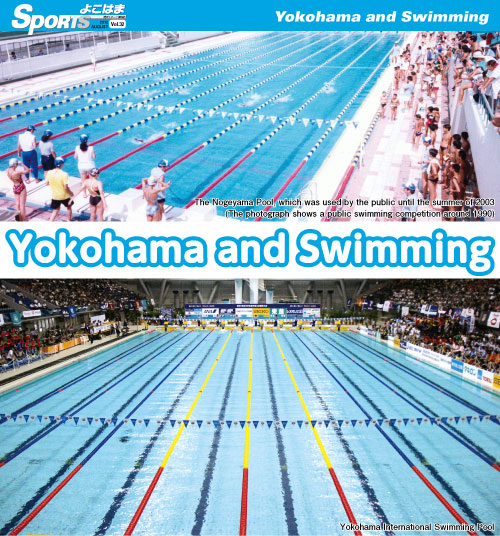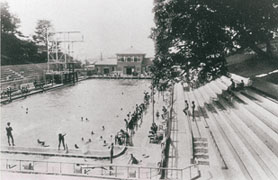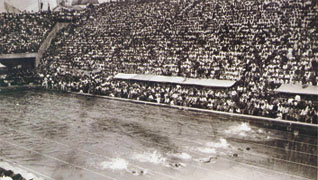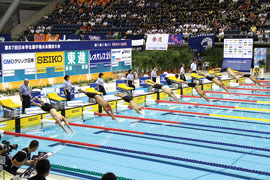SPORTS YOKOHAMA Vol.32:Feature(1/4)

According to surviving records, the first full-fledged international swimming competition in Japan took place in 1898 in the form of a competition between disciples of the Ota group of the Suifu school, trained in traditional Japanese swimming, and the Yokohama Amateur Rowing Club, a Yokohama foreigners club, at the foreigners’natatorium at Nishihatoba (western quay), which corresponds to the base of the current Oosanbashi Pier of Yokohama Port. The Japanese side won two races and lost one.
We are currently in the midst of the swimming season.
Yokohama has seasonal outdoor pools, a year-round indoor pool, and bathing beaches!
Competitive sports, lifelong sports, and recreation!…
…This summer, let’s safely have fun at the pool and the beach, by following their respective rules.
Information and photographs provided by: Yokohama Swimming Association, Photography: Keiji Nakamura, Reporting: Hiroyuki Yoshiyama (Yokohama Sports Association)

In August 1926, construction of the prefecture’s first 25-meter pool was completed at Yokohama No. 2 Middle School (currently Yokohama Suiran High School). The prefecture’s swimming enthusiasts of the various schools in the prefecture would meet mainly there, conducting activities for the development of competitive swimming, and in 1927, the predecessor organization of the Yokohama Swimming Association was founded.
The first public swimming competition (Yokohama Civic Water Tournament) was held in 1928. It took place with spectators crowding around the Yokohama No. 2 Middle School pool.
In 1930, the Motomachi Pool, which used spring water, was built to celebrate the coronation of the Showa Emperor. As the only certified pool in Yokohama at the time, this pool was the venue of the fourth to the twelfth Civic Water Tournaments.
In 1949, construction of the Nogeyama Pool was completed to coincide with the first National Sports Festival held in Yokohama. This certified pool, which featured a 10-meter diving platform in addition to a 50-meter, 8-lane, 180-centimeter deep competition swimming pool, was provided with stands with a huge capacity of 10,000 people.
Hironoshin Furuhashi and other swimming champions who were the driving force behind the development of competitive swimming in post-war Japan competed in the National Sports Festival held in September of that year, and for days on end, the venue was packed with spectators.
Then, in 1998, exactly 100 years after full-fledged international swimming competitions started being held in Yokohama, construction of the Yokohama International Swimming Pool, a full-fledged indoor pool capable of hosting international competitions, was completed in Tsuzuki-ku.
The 9th Pan Pacific Swimming Championships in Yokohama and the FINA Synchronized Swimming World Cup were held there in 2002 and 2006, respectively, having a major impact on the public.
This pool used for world championships also hosts events such as public swimming competitions, and swimming enthusiasts aspire to swim at the Yokohama International Swimming Pool, attesting to the growing importance of this pool.

An early shot of the Motomachi Pool, which opened in 1930
(from “Yokohama Sports Hyakunen no Ayumi”)

The Nogeyama Pool, the venue of heated competitions during the National Sports Festival in 1949 (from “Yokohama Sports Hyakunen no Ayumi”)

The Yokohama International Swimming Pool, which holds public swimming competition in addition to international competitions and all-Japan competitions, is also open to the general public and for official time recording events.

According to surviving records, the first full-fledged international swimming competition in Japan took place in 1898 in the form of a competition between disciples of the Ota group of the Suifu school, trained in traditional Japanese swimming, and the Yokohama Amateur Rowing Club, a Yokohama foreigners club, at the foreigners’natatorium at Nishihatoba (western quay), which corresponds to the base of the current Oosanbashi Pier of Yokohama Port. The Japanese side won two races and lost one.
We are currently in the midst of the swimming season.
Yokohama has seasonal outdoor pools, a year-round indoor pool, and bathing beaches!
Competitive sports, lifelong sports, and recreation!…
…This summer, let’s safely have fun at the pool and the beach, by following their respective rules.
Information and photographs provided by: Yokohama Swimming Association, Photography: Keiji Nakamura, Reporting: Hiroyuki Yoshiyama (Yokohama Sports Association)

In August 1926, construction of the prefecture’s first 25-meter pool was completed at Yokohama No. 2 Middle School (currently Yokohama Suiran High School). The prefecture’s swimming enthusiasts of the various schools in the prefecture would meet mainly there, conducting activities for the development of competitive swimming, and in 1927, the predecessor organization of the Yokohama Swimming Association was founded.
The first public swimming competition (Yokohama Civic Water Tournament) was held in 1928. It took place with spectators crowding around the Yokohama No. 2 Middle School pool.
In 1930, the Motomachi Pool, which used spring water, was built to celebrate the coronation of the Showa Emperor. As the only certified pool in Yokohama at the time, this pool was the venue of the fourth to the twelfth Civic Water Tournaments.
In 1949, construction of the Nogeyama Pool was completed to coincide with the first National Sports Festival held in Yokohama. This certified pool, which featured a 10-meter diving platform in addition to a 50-meter, 8-lane, 180-centimeter deep competition swimming pool, was provided with stands with a huge capacity of 10,000 people.
Hironoshin Furuhashi and other swimming champions who were the driving force behind the development of competitive swimming in post-war Japan competed in the National Sports Festival held in September of that year, and for days on end, the venue was packed with spectators.
Then, in 1998, exactly 100 years after full-fledged international swimming competitions started being held in Yokohama, construction of the Yokohama International Swimming Pool, a full-fledged indoor pool capable of hosting international competitions, was completed in Tsuzuki-ku.
The 9th Pan Pacific Swimming Championships in Yokohama and the FINA Synchronized Swimming World Cup were held there in 2002 and 2006, respectively, having a major impact on the public.
This pool used for world championships also hosts events such as public swimming competitions, and swimming enthusiasts aspire to swim at the Yokohama International Swimming Pool, attesting to the growing importance of this pool.

An early shot of the Motomachi Pool, which opened in 1930
(from “Yokohama Sports Hyakunen no Ayumi”)

The Nogeyama Pool, the venue of heated competitions during the National Sports Festival in 1949 (from “Yokohama Sports Hyakunen no Ayumi”)

The Yokohama International Swimming Pool, which holds public swimming competition in addition to international competitions and all-Japan competitions, is also open to the general public and for official time recording events.
 ハマスポ
ハマスポ
 お知らせ&トピックス
お知らせ&トピックス ページトップへ戻る
ページトップへ戻る ページトップへ戻る
ページトップへ戻る

